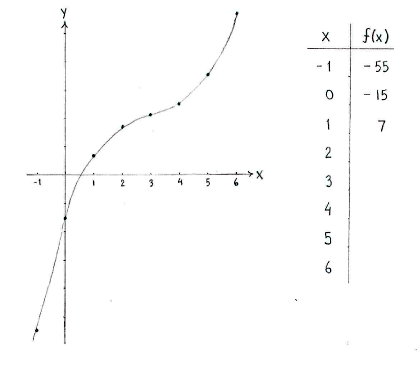Lösung 1.3:2d
Aus Online Mathematik Brückenkurs 2
(Unterschied zwischen Versionen)
K |
|||
| (Der Versionsvergleich bezieht 7 dazwischen liegende Versionen mit ein.) | |||
| Zeile 1: | Zeile 1: | ||
| - | + | Lokale Extremstellen einer Funktion sind entweder: | |
| - | # | + | # stationäre Stellen mit <math>f^{\,\prime}(x)=0</math>, |
| - | # | + | # singuläre Stellen, in denen die Funktion nicht differenzierbarbar ist, oder |
| - | # | + | # Randstellen. |
| + | |||
| + | Da die Funktion ein Polynom ist, ist sie überall definiert und überall differenzierbar. Es gibt also keine Extremstellen, die die Bedienungen 2 und 3 erfüllen. | ||
| - | + | Die Ableitung ist | |
| - | {{ | + | {{Abgesetzte Formel||<math>f^{\,\prime}(x) = 3x^2 - 18x + 30 = 3(x^2-6x+10)</math>}} |
| - | + | und wir erhalten die Gleichung | |
| - | {{ | + | {{Abgesetzte Formel||<math>x^{2}-6x+10=0\,\textrm{.}</math>}} |
| - | + | Die quadratische Ergänzung ergibt | |
| - | {{ | + | {{Abgesetzte Formel||<math>(x-3)^2 - 3^2 + 10 = 0\,,</math>}} |
| - | + | also | |
| - | {{ | + | {{Abgesetzte Formel||<math>(x-3)^2 + 1 = 0\,\textrm{.}</math>}} |
| - | + | Diese Gleichung hat keine Lösung, also hat die Funktion keine lokalen Extremstellen. Bei der Ableitung | |
| - | + | {{Abgesetzte Formel||<math>f^{\,\prime}(x) = 3((x-3)^2+1)</math>}} | |
| - | + | sehen wir, dass sie immer größer als null ist, also ist die Funktion streng monoton steigend. Wir berechnen einige Funktionswerte, um die Funktion zu zeichnen. | |
| - | + | ||
| - | + | ||
| - | + | ||
| - | + | ||
[[Image:1_3_2_d.gif|center]] | [[Image:1_3_2_d.gif|center]] | ||
Aktuelle Version
Lokale Extremstellen einer Funktion sind entweder:
- stationäre Stellen mit \displaystyle f^{\,\prime}(x)=0,
- singuläre Stellen, in denen die Funktion nicht differenzierbarbar ist, oder
- Randstellen.
Da die Funktion ein Polynom ist, ist sie überall definiert und überall differenzierbar. Es gibt also keine Extremstellen, die die Bedienungen 2 und 3 erfüllen.
Die Ableitung ist
| \displaystyle f^{\,\prime}(x) = 3x^2 - 18x + 30 = 3(x^2-6x+10) |
und wir erhalten die Gleichung
| \displaystyle x^{2}-6x+10=0\,\textrm{.} |
Die quadratische Ergänzung ergibt
| \displaystyle (x-3)^2 - 3^2 + 10 = 0\,, |
also
| \displaystyle (x-3)^2 + 1 = 0\,\textrm{.} |
Diese Gleichung hat keine Lösung, also hat die Funktion keine lokalen Extremstellen. Bei der Ableitung
| \displaystyle f^{\,\prime}(x) = 3((x-3)^2+1) |
sehen wir, dass sie immer größer als null ist, also ist die Funktion streng monoton steigend. Wir berechnen einige Funktionswerte, um die Funktion zu zeichnen.

